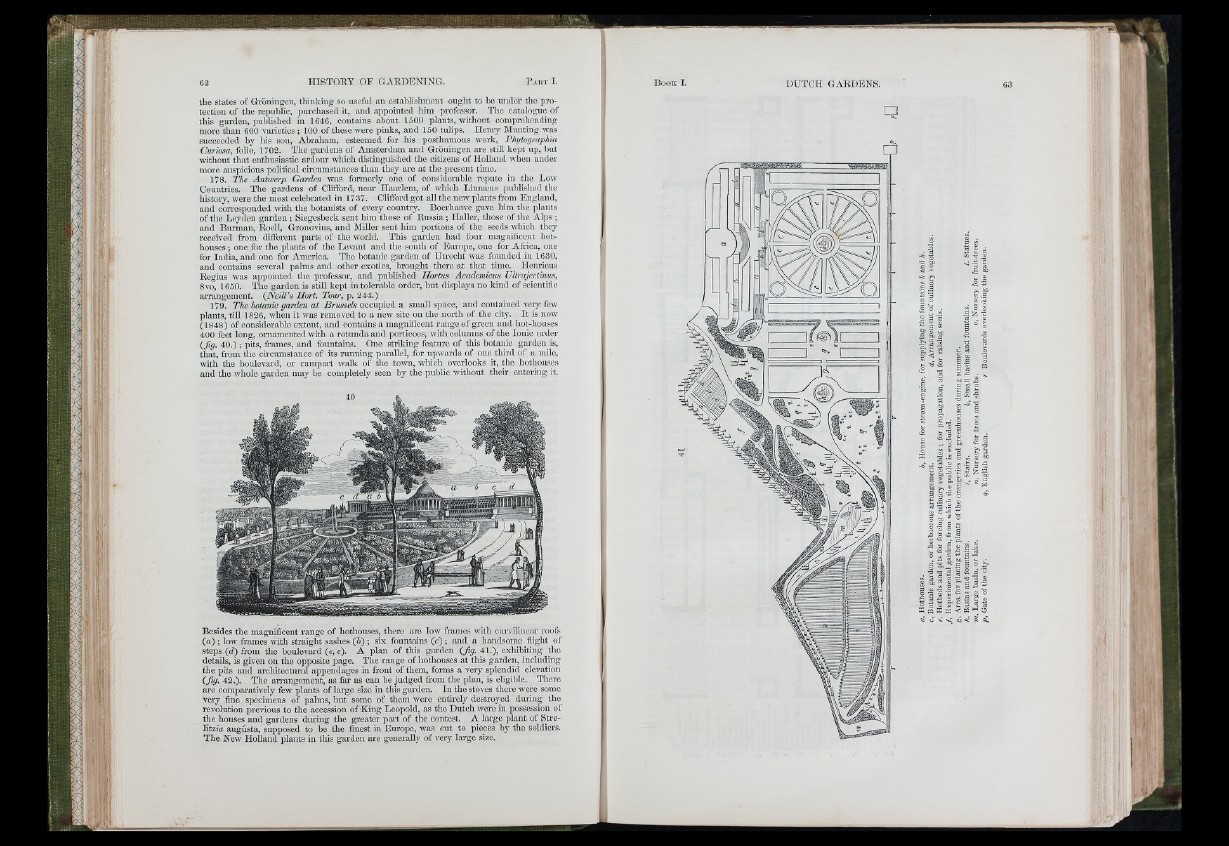
IF
IL
T7
i
the states of Groningen, thinking so useful au establisliuicut ought to be under the protection
of the republic, purchased it, and appointed him professor. I'h e catalogue of
this garden, published in 1646, contains about 1500 plants, without comprehending
more than 600 vm-icties ; 100 of these were pinks, and 150 tulips. Henry Mimting was
succeeded hy his son, Abraham, esteemed for his posthumous Avork, Phytographia
Curiosa, folio, 1702. The gardens of Amsterdam and Groningen arc still kept up, bnt
Avithout that entliusiastic ardour which distinguished the citizens of Holland when under
more auspicious political cfrcumstances than they are at the present time.
178. The Antwerp Garden Avas formerly one of considerable repute in the L oav
Countries. The gardens of Clifford, near Haarlem, of Avhich Linnæus published the
history, Averc the most celebrated in 1737. Clifford got all the ncAv plants from England,
and con-cspondcd Avitli the botanists of every country. Boerhaave gave him the plants
of the Leyden garden ; Siegesbeck sent him those of Russia ; Haller, those of the Alps ;
and Burman, Roell, Gronovius, and Miller sent him portions of the seeds Aidiich they
received from different pai'ts of the world. This garden had four magnificent hothouses
; one for the plants of the Levant and the south of Europe, ono for Africa, one
for India, and one for America. The botanic garden of Utrecht Avas founded in 1630,
and contains several palms and other exotics, brought there at that time. Henricus
Regius Avas appointed the professor, and published Hortus Academicus Ulirajectmus,
8a^o, 1650. The garden is still kept intolerable order, but displays no kind of scientific
aiTangemcnt. (NeilVs Hort. Toui', p. 244.)
179. The botanic garden at Brussels o c c u p ie d a sm a ll s p a c e , a n d c o n ta in e d v e r y fcAV
p la n ts , t i l l 1826, Avhen it Avas r em o v e d to a ncAv s ite o n th e n o r th o f th e c ity . I t is noAV
(1 8 4 8 ) o f c o n s id e r a b le e x t e n t, a n d c o n ta in s a m a g n if ic e n t r a n g e o f g r e e n a n d h o t-h o u s e s
400 fe e t lo n g , o rn am e n te d w i th a r o tu n d a a n d p o rtic o e s , Avith c o lum n s o f th e I o n i c o r d e r
(fig. 40.) ; p its , f r am e s , a n d fo u n ta in s . O n e s t r ik in g f e a tu r e o f th is b o ta n ic g a r d e n is,
th a t , fr om th e c ir c um s ta n c e o f i ts r u n n in g p a r a lle l, fo r npAvards o f o n e t h i r d o f a m ile ,
Avith th e b o u le v a rd , o r r a m p a r t w a lk o f th e toAvn, Avhicli o v e r lo o k s i t, th e h o tlio u s e s
a n d th e w h o le g a r d e n m a y b e c om p le te ly se e n b y th e p u b lic w i th o u t th e i r e n t e r in g it.
Besides the magnificent range of hothouses, there are low frames with curvilinear roois
(a ) ; loAv frames Avith straight sashes (6) ; six fountains (c) ; and a handsome flight of
.steps (d) fi-om the boulevard (e, e). A plan of this garden (fig. 41.), exhibiting tho
details, is given on the opposite page. The range of hothouses at this garden, including
the pits and arclfitectin-al appendages in front of them, forms a vei-y splendid elevation
(fig. 4 2 .). The an-angement, as far as can be judged from the plan, is eligible. There
are comparatively few plants of lai'ge size in this garden. In the stoves there were some
very fine specimens of palms, but some of them were entirely destroyed during the
revolution previous to the accession of liin g Leopold, as the Dutch Avere in possession of
the houses and gardens during the greater pai-t of the contest. A large plant of Strelitzia
augusta, supposed to he the finest in Europe, was cut to pieces by the soldiers.
The New Holland plants in this garden ai-c generally of very large size.
i s
I i l l
a
Z ^ s
I 1 1 i i s
• Is U tn .i: t; .a
l & l s
» S B "
g 6« > B
i - a
. I t s H i l
I a | p i l l
e «T «T fei <r s* »;